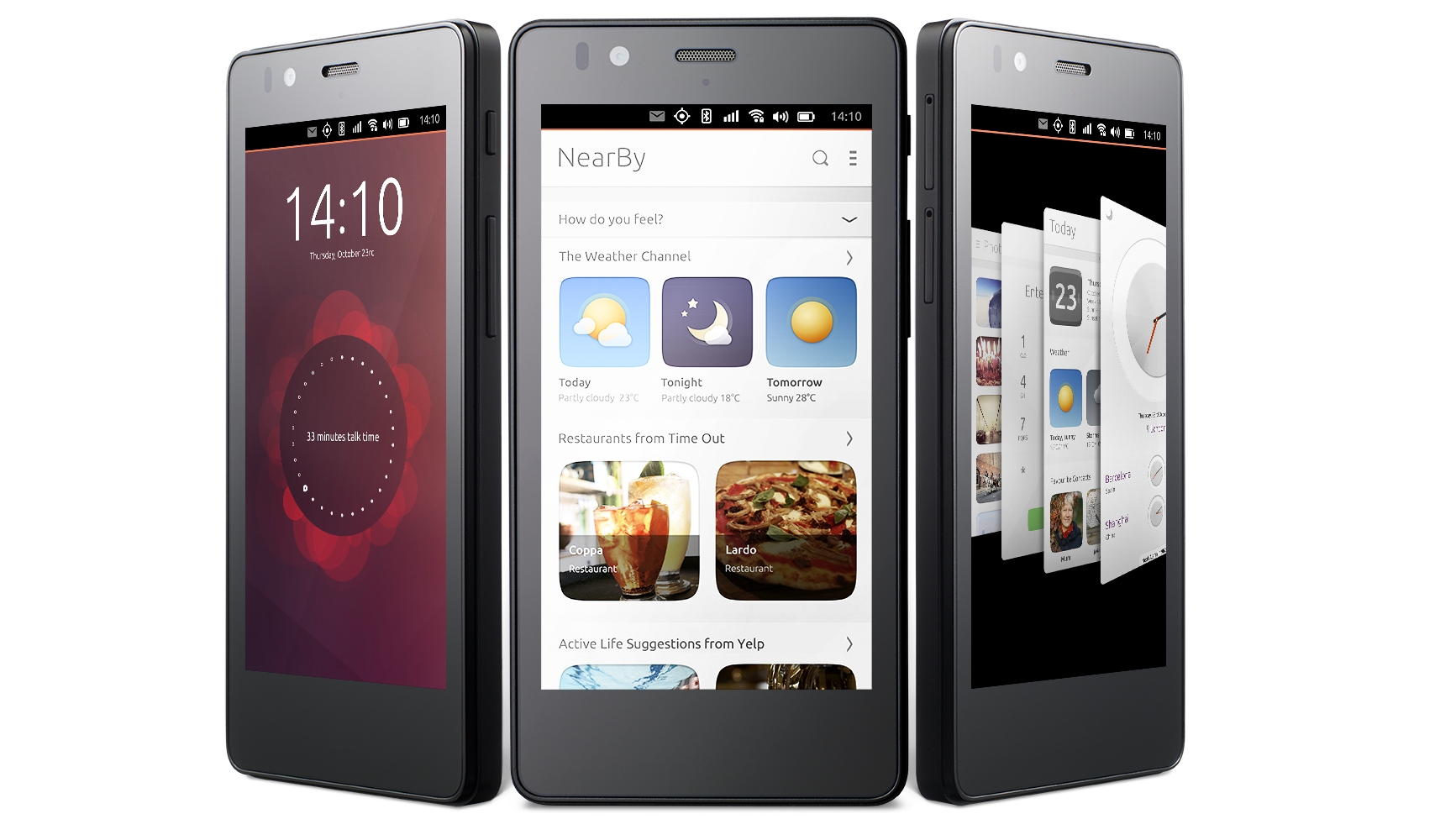Early Verdict
For anyone who has become frustrated with both major operating systems, the streamlined and more intelligently designed, intuitive interface of Ubuntu for smartphones shows more attention to detail than either iOS or Android, though whether it's revolutionary enough to succeed is debatable.
Pros
- +
Streamlined interface
- +
Thought has been put into user interface
- +
Free and open source
Cons
- -
Revolutionary enough to succeed?
- -
Scopes could be divisive
- -
Buggy
Why you can trust TechRadar
The tech landscape is dominated by the smartphone and the tablet. These in turn are lorded-over by two competing operating systems familiar to us all, namely Apple's iOS and Google's Android, which can never be deposed, not even by Microsoft's millions. Right?
Not so. While Apple and Google slug it out with periodic updates to try and outdo each other, and in doing so hopefully tempt us tech buyers to swap from one major operating system to another, there are other smartphone-centric platforms out there vying for to be dominant in the longer term.

For example Windows Phone, has faltered due to its muddled tablet and desktop variants and lack of app support, and hasn't had much of an impact so far, though Microsoft hopes to change its fortunes with Windows 10 Mobile.
And then there are a the smaller and virtually unknown mobile platforms such as Jolla's Sailfish that are now starting to get some attention, with probably the most well-known being Ubuntu.
Several operating systems are fighting for the title of up-and-coming 'third ecosystem', and Ubuntu Phone has emerged as a new challenger.
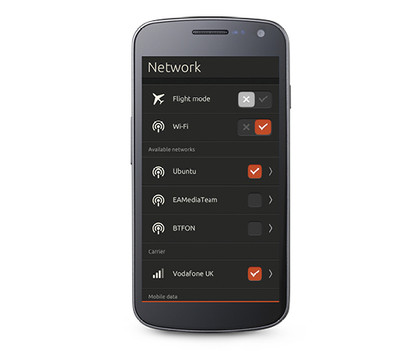
Canonical, the company behind Ubuntu, was at MWC 2015 showing off two new Ubuntu-powered smartphones, the BQ Aquaris E4.5 Ubuntu Edition and Meizu MX4 Ubuntu Edition. This gave me a chance to play around with the latest version of Ubuntu Phone to find out what has changed since we last tried it out.
Scopes
One of the biggest challenges facing new mobile operating systems is the lack of apps. People with an iPhone or Android device are often reluctant to move to a new OS if it doesn't have their favourite apps and games. Just ask Microsoft.
Sign up for breaking news, reviews, opinion, top tech deals, and more.
Canonical is all too aware of this problem and has decided to face it head on. Cristian Parrino, Vice President of Mobile and Online Services at Canonical, told me that while most mobile operating systems attempt to build an audience first and then persuade app developers to port their apps to the platform thanks to the size of the audience, with Ubuntu Phone Canonical is flipping this process; building up the app ecosystem first in a bid to convince people to move over.
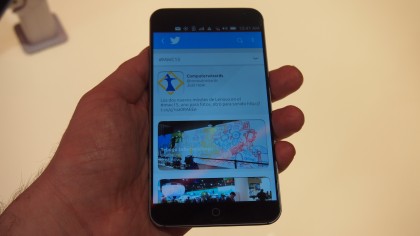
It makes sense, though how do you get people to create apps if there's no audience? Canonical has a few tricks up its sleeve, with Scopes being the key.
Scopes, which as Parrino, claims, is "a game changer", allows people to make Scopes at a fraction of the cost – in both the financial and time sense – that it takes to create an app.
Each Scope aggregates services and content, giving users a different way to open apps and read news stories, and the simplicity of creating Scopes means that developers shouldn't have to devote much time to creating good looking and useful Scopes rather than bespoke apps.
I tried out the NearBy Scope, which uses your location to aggregate local services, and I was able to view reviews of local restaurants and check the weather forecast at the same time. This was a powerful demonstration of the potential of Scopes, as in conventional mobile operating systems like iOS and Android I would have needed to open a series of separate apps to get the same information.
I also tried the BBC News Scope, which acted like a fancy RSS feeder that supplied headlines of the latest news, while clicking these took me through to the BBC website.
My time trying out Scopes showed that there is potential here and its clear that businesses and websites can quickly create their very own Scope. However it also feels like you need an active data connection to make the most out of Scopes, which might not please everybody.
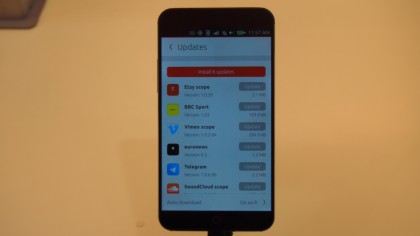
Ubuntu Phone also supports native apps written in either HTML5 or Qt Quick, which brings me to the final string in Ubuntu Phone's app bow: user created apps. As expected from a Linux distribution, Ubuntu has a loyal following of developers who are happy to create an app if one doesn't exist, and Canonical hopes this community will plug the gaps. With services such as Spotify opening up its API to developers it means that although there isn't an official app, there is an Ubuntu Phone app for playing songs from Spotify.
So has this strategy worked? We've been told by Parrino that we can expect some big name apps appearing on the new mobile operating system. When asked what sort of apps and Scopes we can expect in Ubuntu Phone, he replied "Several. Facebook, Twitter, eBay, Time Out, Yelp, as well as community developed apps working on Spotify, Dropbox APIs. Lots. Just about every digital platform, in some cases the top brand, others from valid alternatives".
However there was one major app that won't be appearing on Ubuntu Phone just yet - WhatsApp. The incredibly popular social app won't be part of the almost 1,000 apps from big names around the world that are coming to Ubuntu Phone.
Apps
Although making phone calls and sending text messages is handled in a similar fashion to iOS and Android devices, there is currently no default app for emails preinstalled on Ubuntu Phone. Canonical suggests using Dekko, a pared down and rather simplistic email client that does the job at least.
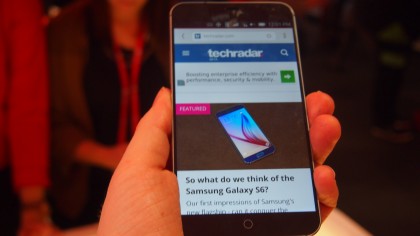
The Gmail web app was also installed, but as this was a web app, it simply took you to the Gmail inbox website, which didn't display properly. The default web browser is Canoncial's own creation, though it's based on the Chromium engine, delivering an experience similar to Google's Chrome web browser.
Another of the platform's own apps is Gallery, an effort to create a timeline-organised history of your life through photos. Yes, it's a bit like Facebook, though don't get us started on that particular social media app for smartphones (grrr … adverts). Gallery draws in images from wherever you choose, and orders them by date.
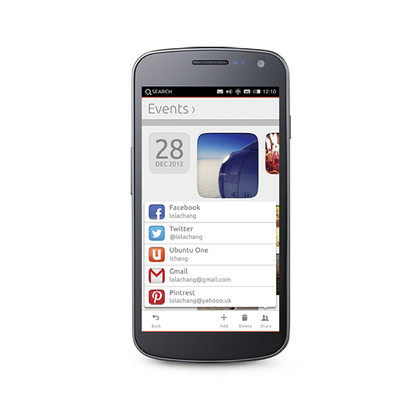
Unless you delve a lot deeper, it's all about content to the exclusion of little-used control; pictures are shown as thumbnails, and by 'event' (time taken), are scroll-able left and right, and can be made full-screen, but unless you then touch the bottom of the screen you'll never need to see controls to share, enhance or crop it.
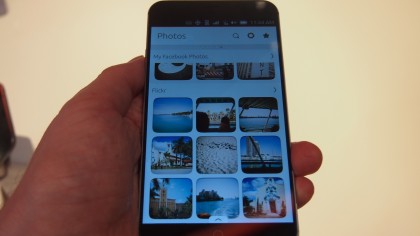
The native camera app will be pretty familiar to anyone who has used Google's stock Android camera app. It includes a range of standard features such as GPS connectivity to tag your photos with your location information, flash settings, a timer and quality settings.
There's nothing particularly flashy here, but it does the job in a straightforward way, and you can set where the camera focuses by tapping on the screen of the device.
Canonical is envisioning a future where any app that can run on the desktop version of Ubunutu can run on Ubuntu Phone, with this convergence planned to happen in the next 12 months. Hopefully when we revisit Ubuntu Phone later on, we should see more native apps becoming available.

Edge control
From the beginning everything in Ubuntu Phone was designed around the edges of the smartphone screen, and its first act was to impress us with the way it relies on gestures and drags rather than taps on apps.
A quick swipe from the left brings up a list of shortcuts to your favourite apps and Scopes, and is a similar layout to the Unity menu bar in the desktop version of Ubuntu. Quickly swiping your finger up from the bottom edge brings up a list of all open Scopes, while a slow, deliberate drag of the finger from the right-hand side brings up a 3D carousel list of apps and Scopes that you can flick through. A quicker swipe from the right flicks back and forth between your last open app.
With the screen locked notifications can be displayed, which is a nice touch and allows you to quickly open up whatever app the notification belongs to.
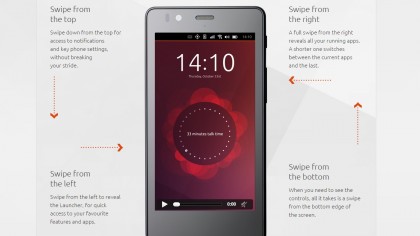
Ubuntu Phone speeds-up the process of changing the options on your phone by making barely used utility settings, such as Network, Date, Message sand Sound and sound parameters, speedily accessible merely by dragging a finger down from the top edge of the phone.
A rapidly changing carousel of settings appears, and when you get to the one you need, you simply drag that finger down to select it and blow it up to full-screen. It gets rid of taps, yes, but it makes things quicker and much cleaner. The 'across, down, select option' idea isn't new, and feels much like how, say, Microsoft Word works on a desktop computer, though on Ubuntu Phone the experience is both compressed and - unless you want to see it - completely hidden from your everyday use of your smartphone. Gone are lists, menus, pages full of options, and other admin annoyances - and even soft-key buttons.
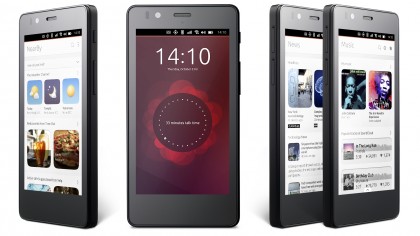
The interface worked well, though there are still plenty of bugs that caused apps and web pages to display incorrectly. I'd have liked to have taken some new screenshots of Ubuntu Phone, but during the time I used Ubuntu Phone there was a bug that means any screenshots taken had the on screen volume control icons plastered across them, so don't expect a flawless user experience just yet.
Home page
Home screens that hold all your smartphone's apps are mainstays on iOS and Android, but with Ubuntu Phone's focus on Scopes over apps, there currently isn't a dedicated Home page. In an earlier version of Ubuntu Phone that we tried a few years ago there was, but this has been dropped in favour of a series of Scope screens that you can flick through, with the Today scope that lists the weather, calendar and recent calls acting as the default Scope.
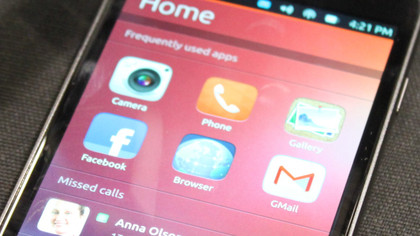
Canoncial's commitment to Scopes is admirable, with Parrino going as far as to tell me that they are fundamental to the Ubuntu Phone experience, which means Ubuntu Phone could live or die by how popular Scopes become.
The current lack of a homescreen can prove to be a bit disorientating at first, especially when you're in an app or a menu and want to return to your apps. Pressing the Ubuntu icon on the left-hand screen simply brings you back to your last open Scope. If you want a quick overview, you need to instead swipe up to view the list.

Early verdict
Will Ubuntu Phone make an impact? For anyone who has become frustrated with both major operating systems, the streamlined and more intelligently designed, intuitive interface of Ubuntu Phone shows more attention to detail than either iOS or Android, though whether it's revolutionary enough to succeed is debatable.
Ubuntu has enough recognition among Linux users to at least guarantee a niche audience who will be forgiving of the bugs and lack of official apps. However Canoncial has been vocal about its ambitions to bring Ubuntu Phone to the mainstream and tempt people who haven't heard of Linux to ditch Android or iOS. In its current state, Ubuntu Phone has a major struggle on its hands, as it still doesn't have the apps to convince people to migrate.

The software is also buggy, and although this will no doubt be fixed eventually, at the moment I wouldn't recommend Ubuntu Phone for people who just want an easy life. It does have plenty of potential though, and Canoncial is aiming to bring Ubuntu Phone to retail in around 12 months, so there is plenty of time to iron out some of its problems.
Although you can't buy Ubuntu Phone devices in stores until next year, you can buy the BQ Aquaris E4.5 Ubuntu Edition and Meizu MX4 Ubuntu Edition smartphones online if you can't wait to try out Ubuntu Phone. You can also download the operating system onto older Nexus devices, though I'd be cautious of installing it onto your main smartphone for now.
The biggest question is how will people take to Scopes? As Ubuntu Phone is so focused around the idea, if it fails to catch on it could spell the end of Canoncial's hopes to transcend the desktop.
I like the ambition behind them, and aggregating various services into one easy to digest screen is pretty handy. It's also a good way of getting big names on Ubuntu Phone without having to convince them to spend time writing an app.
But will an abundance of Scopes make up for a lack of apps? At the moment, I'm not too convinced.
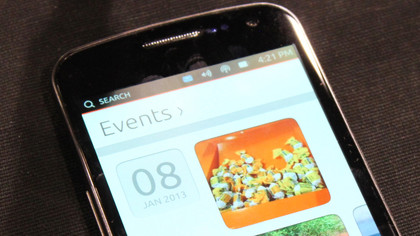

Matt is TechRadar's Managing Editor for Core Tech, looking after computing and mobile technology. Having written for a number of publications such as PC Plus, PC Format, T3 and Linux Format, there's no aspect of technology that Matt isn't passionate about, especially computing and PC gaming. He’s personally reviewed and used most of the laptops in our best laptops guide - and since joining TechRadar in 2014, he's reviewed over 250 laptops and computing accessories personally.
What is a hands on review?
Hands on reviews' are a journalist's first impressions of a piece of kit based on spending some time with it. It may be just a few moments, or a few hours. The important thing is we have been able to play with it ourselves and can give you some sense of what it's like to use, even if it's only an embryonic view. For more information, see TechRadar's Reviews Guarantee.
